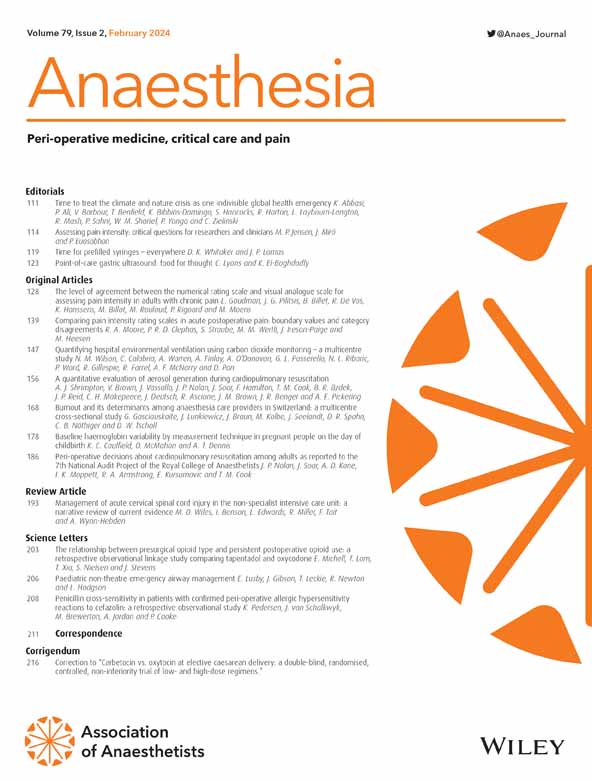Efficacy of laparoscopic-installed rectus sheath block for postoperative pain reduction in transabdominal preperitoneal inguinal hernia repair: a double-blind, randomised-controlled trial.
IF 7.5
1区 医学
Q1 ANESTHESIOLOGY
引用次数: 0
Abstract
INTRODUCTION Postoperative pain management plays a crucial role in early recovery after laparoscopic inguinal hernia repair, particularly as most repairs are done as day-case surgery. The aim of this study was to evaluate the anaesthetic effect of a laparoscopically-guided rectus sheath block on postoperative pain. METHODS Within this prospective, double-blinded, randomised controlled trial, patients planned for inguinal hernia repair using the transabdominal preperitoneal patch plastic were recruited. Patients were assigned randomly to either a control group or an intervention group. Both received standardised pre-emptive anaesthesia during the surgical procedure with self-fixating mesh. In the intervention group, an intra-operatively implemented rectus sheath block was performed for postoperative pain control. The primary outcome was the postoperative pain score 3 h after surgery. RESULTS Thirty-five patients were included in the study; 17 patients were randomised to the intervention group and 18 to the control group. Patient demographics and procedural times were similar in both groups. Postoperative median (IQR [range]) pain scores were not significantly different between the groups 3 h after surgery (intervention group 3.0 (3.0-5.0 [1.0-8.0]) vs. control group 3.5 (2.25-4.75 [1.0-8.0]); p = 0.854). The median (IQR [range]) oxycodone requirement after surgery was not different between the groups (intervention group 0 (0-3 [0-7]) mg vs. control group 0 (0-3 [0-7]) mg; p = 0.869). DISCUSSION This study has shown that a laparoscopic rectus sheath block has no beneficial effect in postoperative pain management following laparoscopic transabdominal inguinal hernia repair.腹腔镜下安装直肌鞘阻滞对经腹腹膜前腹股沟疝修补术后疼痛减轻的疗效:一项双盲、随机对照试验。
术后疼痛管理在腹腔镜腹股沟疝修补术后的早期恢复中起着至关重要的作用,特别是因为大多数修补都是日常手术。本研究的目的是评估腹腔镜引导下直肌鞘阻滞对术后疼痛的麻醉效果。方法在这项前瞻性、双盲、随机对照试验中,招募了计划使用经腹腹膜前贴片塑料修复腹股沟疝的患者。患者被随机分为对照组和干预组。在手术过程中,两例患者均使用自固定补片进行标准化的先发制人麻醉。在干预组中,术中实施直肌鞘阻滞以控制术后疼痛。主要观察指标为术后3小时疼痛评分。结果35例患者纳入研究;17例患者随机分为干预组,18例患者分为对照组。两组患者的人口学特征和手术时间相似。术后3 h,干预组3.0(3.0-5.0[1.0-8.0])与对照组3.5(2.25-4.75[1.0-8.0])疼痛评分中位数(IQR[范围])组间差异无统计学意义;p = 0.854)。术后氧可酮需要量中位数(IQR[范围])组间差异无统计学意义(干预组0 (0-3 [0-7])mg与对照组0 (0-3 [0-7])mg;p = 0.869)。本研究表明,腹腔镜下腹直肌鞘阻滞对腹腔镜经腹股沟疝修补术后疼痛管理无有益作用。
本文章由计算机程序翻译,如有差异,请以英文原文为准。
求助全文
约1分钟内获得全文
求助全文
来源期刊

Anaesthesia
医学-麻醉学
CiteScore
21.20
自引率
9.30%
发文量
300
审稿时长
6 months
期刊介绍:
The official journal of the Association of Anaesthetists is Anaesthesia. It is a comprehensive international publication that covers a wide range of topics. The journal focuses on general and regional anaesthesia, as well as intensive care and pain therapy. It includes original articles that have undergone peer review, covering all aspects of these fields, including research on equipment.
 求助内容:
求助内容: 应助结果提醒方式:
应助结果提醒方式:


